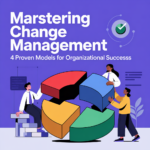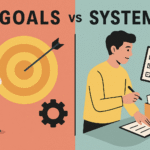Mastering Change Management: 4 Proven Models for Organizational Success
Discover effective change management strategies, explore Kotter's 8-Step Process, ADKAR, Lewin, and McKinsey models, and learn how to implement successful organizational change.

Change is no longer a one-time event, it’s a constant. In today’s fast paced, technology-driven world, organizations must adapt rapidly to shifting market demands, evolving customer expectations, and internal innovations. Yet, navigating change is rarely simple. Without a clear roadmap and proper execution, even the most well-intentioned transformations can result in confusion, resistance, and costly setbacks. That’s where change management comes in.
Change management is not just about implementing new systems or processes; it’s about guiding people through the transition in a way that minimizes disruption and maximizes engagement. Whether you’re rolling out a digital transformation, restructuring teams, or updating company policies, a well-structured change management approach is critical to success.
In this blog post, I will break down the fundamentals of change management. What is change management, why it matters, and how to do it right. You’ll discover the key principles that underpin successful change initiatives, explore time-tested models like Kotter’s 8-Step Process and the ADKAR model, and learn actionable strategies to help your organization not just survive change, but thrive because of it.
Key Principles of Successful Change Management
Most change initiatives don’t fail because the strategy was flawed. They fail because people were not aligned, informed, or invested. I’ve seen it firsthand: a shiny new process introduced overnight with no explanation, only to be quietly ignored or actively resisted. It’s not that people fear change; they fear disruption without clarity. Research backs this up. A study published in ScienceDirect emphasizes that “Evidence-Based Change Management is the science-informed practice of managing planned organizational change,” highlighting the importance of aligning people, culture, and goals to drive lasting transformation. That means principles like trust, transparency, and vision aren’t just ‘soft’ ideas, they’re structural pillars.
Let’s explore the foundational elements that make or break change:
1. Leadership Alignment in Change Management
Effective change needs committed leadership not just in title, but in behaviour. Leaders must model the change they want to see, reinforcing priorities with consistent communication and visible involvement. Prosci’s change management research shows that active and visible sponsorship is the number 1 success factor in organizational change .
I still remember a manager I worked with at the time the company was switching from one customer relationship management (CRM) system. The change itself wasn’t complex but what stood out was how she handled it. Instead of simply emailing the team instructions, she was the first to use the tool in meetings, admitted her own learning curve, and openly invited feedback. That made a huge difference. It created a tone of trust and collaboration that made people want to adapt.
Contrast that with a time when an application we relied on daily was suddenly updated, no heads-up, no training, just a new interface staring back at us on Monday morning. We were expected to figure it out on the fly, while still hitting our regular performance targets.The update itself wasn’t the problem, it probably did improve some things under the hood. But because there was no communication, no walkthrough, and no space to adjust, frustration quickly set in. Everyone was stressed, fumbling through the new layout while trying not to fall behind.
The resistance wasn’t about the change being difficult, it was about being left in the dark. When people feel like change is being done to them instead of with them, they disengage. Leadership sets the temperature of the room. When leaders engage with change personally, they signal that it matters. When they don’t, it often dies on arrival.
2. Creating Urgency in Change Management
If people don’t understand the “why,” they won’t care about the “how.” Successful change initiatives begin by clearly articulating a compelling reason for change—whether it’s driven by data, customer feedback, competitive pressure, or internal inefficiencies. The American Society for Quality (ASQ) emphasizes that effective change management helps organizations overcome resistance, align teams, and build the momentum needed to move forward.
3. Vision and Direction in Change Management
People need to know where they’re going, not just what they’re leaving behind. A clear vision should communicate not only the outcome but the benefits of getting there for the team, the organization, and individuals. According to John Kotter’s 8-Step Model, developing and communicating the vision is essential for aligning efforts (Kotter, 1996).
4. Stakeholder Engagement in Change Management
Change isn’t something you do to people, it’s something you build with them. Successful organizations identify key stakeholders and involve them early in shaping how the change unfolds. The ADKAR model emphasizes “Desire” as a critical stage meaning stakeholders must want to support the change.
5. Communication Strategies in Change Management
Communication isn’t a one-time memo, it’s a campaign. As noted by HBS, consistent, transparent messaging that flows both ways is vital. Good communication involves not just announcements, but listening and adjusting based on concerns or confusion.
6. Feedback and Flexibility in Change Management
No change initiative goes exactly as planned. That’s why feedback loops are essential, to measure sentiment, course-correct, and reinforce progress. As ASQ suggests, monitoring progress ensures the organization can “respond proactively to challenges”
Proven Change Management Models
There’s no one-size-fits-all when it comes to managing change, but there are frameworks that help us avoid the chaos of guesswork. These models are like GPS systems, they won’t drive the car for you, but they’ll help you navigate the route with fewer wrong turns.
Here are some of the most trusted and widely used change management models that can guide organizations through successful transformation:
1. Kotter’s 8-Step Change Model
Developed by Dr. John Kotter, this model outlines a step-by-step approach for leading change. It emphasizes creating a sense of urgency, building coalitions, and embedding change into company culture.

The 8 Steps:
- Create a sense of urgency
- Build a guiding coalition
- Form a strategic vision and initiatives
- Enlist a volunteer army
- Enable action by removing barriers
- Generate short-term wins
- Sustain acceleration
- Institute change
Here is why it works, it focuses on momentum and leadership buy-in, which is especially useful for large-scale transformations.
2. ADKAR Model (by Prosci)
This model breaks change down to the individual level. It argues that successful organizational change only happens when each person is guided through five key building blocks:
ADKAR stands for:
- Awareness of the need for change
- Desire to support the change
- Knowledge of how to change
- Ability to demonstrate new skills
- Reinforcement to sustain the change
What makes it effective is its focus on the human side of change, helping HR professionals, team leads, and project managers address the specific needs individuals have during transitions, rather than just outlining organizational changes.
3. Lewin’s Change Management Model
One of the earliest models, Kurt Lewin’s approach is simple but powerful. It views change as a three-stage process:
- Unfreeze – prepare people for change by challenging the status quo
- Change – introduce the new behavior or process
- Refreeze – solidify the new way as the new normal
This model is particularly effective when teams are resistant to change or deeply embedded in existing routines. The “Unfreeze” phase ensures people are mentally and emotionally prepared before any new processes are introduced.
4. McKinsey 7-S Framework
This model is more strategic and looks at seven interrelated elements that all need to be aligned for change to stick:
- Strategy
- Structure
- Systems
- Shared values
- Style (leadership)
- Staff
- Skills
This is best for organizational-level analysis, especially when aligning internal operations during a transformation.
These models aren’t just for consultants, they’re practical tools anyone can use to bring structure to the messiness of change. Whether you’re leading a full reorganization or helping your team adapt to a new tool, choosing the right model gives you clarity, credibility, and confidence.
Implementing Change Management in Your Organization
Knowing what to do is one thing, knowing how to start is another. Effective change management isn’t just about frameworks; it’s about applying them thoughtfully, consistently, and with your team in mind. Here’s a practical roadmap to make it happen:
1. Assess the Need for Change
Before anything else, define what’s driving the change. Is it a drop in customer satisfaction? New technology? A shift in strategy? Take a clear-eyed look at current performance, pain points, and opportunities. Without a compelling “why,” even the best implementation plans will fall flat.
2. Build a Change Leadership Team
Change is a team sport. Identify a group of influential individuals, managers, team leads, and respected peers, who will champion the change. Make sure they’re aligned, trained, and genuinely committed to seeing the process through. Your leadership team sets the tone. If they’re skeptical or disengaged, the rest of the organization will be too.
3. Develop a Clear, Flexible Strategy
Map out what success looks like, what milestones need to be hit, and what resources will be required. But stay adaptable. The best strategies leave room for course correction based on feedback and results.
4. Communicate Early, Often, and Honestly
Change communication should start before the first step is taken and continue throughout. Share the why, the what, and the how in simple, clear terms.
And just as importantly: listen. Create spaces where people can voice concerns and ask questions. If people don’t hear it from you, they’ll fill in the gaps with assumptions—and those usually skew negative.
5. Equip and Empower Your People
Don’t assume everyone will figure it out as they go. Provide relevant training, time to adjust, and access to support. Empower individuals to contribute to the change, not just comply with it.
6. Track Progress and Celebrate Wins
Use metrics, feedback, and regular check-ins to measure progress. Celebrating small wins along the way reinforces momentum and helps people feel that the effort is worth it.
7. Adapt, Reinforce, and Sustain
Once change is underway, reinforce it through policies, rewards, and cultural norms. If something isn’t working, adjust. The goal isn’t to follow the plan perfectly—it’s to get to the outcome successfully.
Embracing Change Management for Growth
Use metrics, feedback, and regular check-ins to measure progress. Celebrating small wins along the way reinforces momentum and helps people feel that the effort is worth it. Change is not just an operational necessity it’s an opportunity. When approached strategically, it becomes a vehicle for innovation, resilience, and long-term growth. But to get there, organizations need more than plans and processes. They need people empowered, engaged, and aligned with the vision.
The most successful companies don’t just react to change; they build cultures that are ready for it. They prioritize communication, involve stakeholders early, and treat change not as a disruption but as a natural part of evolving. That mindset shift is where transformation truly begins.
If there’s one lesson I’ve learned from both smooth and rocky transitions, it’s this: Change doesn’t fail because people resist it, it fails because people don’t trust it. Build that trust with clarity, empathy, and action, and you’ll not only survive change you’ll grow because of it. If you’re leading or facing a change in your organization, take a breath. Then take a step. Start with people. Equip them. Listen to them. Bring them along. Because when people move with the change, not against it, that’s when real progress happens.


